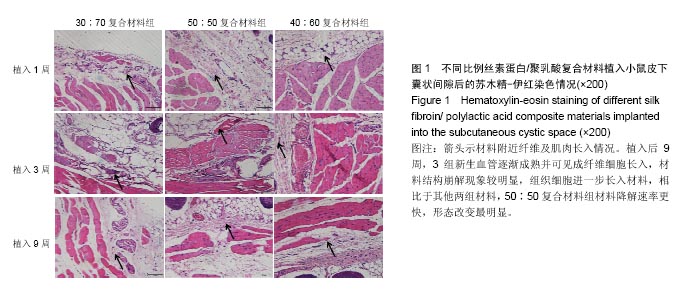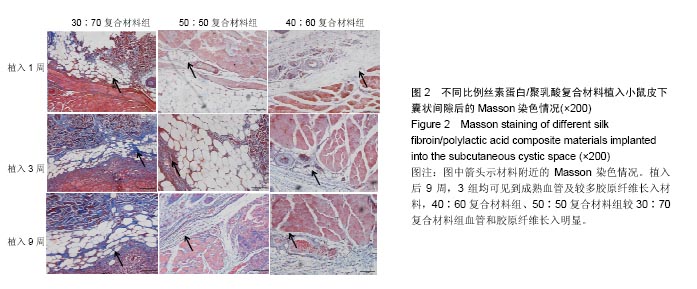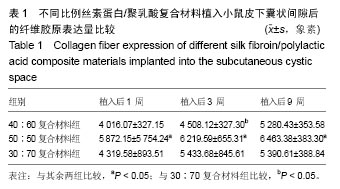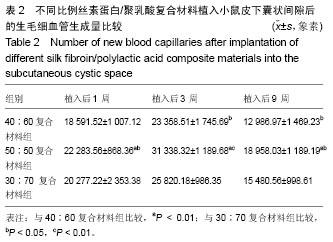中国组织工程研究 ›› 2017, Vol. 21 ›› Issue (34): 5493-5498.doi: 10.3969/j.issn.2095-4344.2017.34.014
• 生物材料模型构建 biomaterial modeling • 上一篇 下一篇
不同比例丝素蛋白/聚乳酸复合材料在小鼠体内的降解速率
肖 冬,崔香艳,王 苹,房 宁,汪 欣
- 吉林大学第一医院耳鼻咽喉头颈外科,吉林省长春市 130021
Degradation of silk fibroin/polylactic acid composites at different proportions in mice
Xiao Dong, Cui Xiang-yan, Wang Ping, Fang Ning, Wang Xin
- Department of Otorhinolaryngology, First Hospital of Jilin University, Changchun 130021, Jilin Province, China
摘要:
文章快速阅读:
.jpg)
文题释义:
丝素蛋白:具有机械性能好、无毒副作用、易于加工成膜或其他形式的支架、可支持细胞黏附和增殖等优点,但天然丝素蛋白的生物降解性较差,应用中经常需要改变其结构才能得以应用。
聚乳酸:具有良好的透气性、可抗菌、防潮、抗紫外线等优点,但存在机械性差、加工难度大、不耐热、疏水等缺点,在实际应用中也常常受到限制。
理想的组织工程生物材料:①良好的生物相容性,无毒副作用,降解时无危害,便于细胞的黏附与增殖;②具有与新生组织形成速率相适应的降解速率,并且易于控制;③较高面积体积比的三围多孔隙结构,便于营养物质进入和代谢物的排出,便于细胞的黏附生长以及细胞外基质的沉积;④构建材料的原料易于获得,并需具有一定的机械性和可塑性,对新生组织结构有支撑作用,易于生产。
背景:前期研究制备了不同混合比例的丝素蛋白/聚乳酸复合材料,经全身过敏反应、急性毒性、溶血、热源及细胞共培养实验证实其具有良好的组织工程材料性能。
目的:考察不同混合比例丝素蛋白/聚乳酸复合材料在小鼠皮下的降解情况。
方法:在54只ICR小白鼠脊柱两侧分别制作皮下囊状间隙,随机分为3组,分别植入丝素蛋白与聚乳酸质量比为30∶70、40∶60、50∶50的丝素蛋白/聚乳酸复合材料,植入后1,3,9周取植入处组织,进行组织病理切片苏木精-伊红染色、Masson染色和CD34免疫组织化学染色。
结果与结论:①苏木精-伊红染色:植入后9周,3组新生血管逐渐成熟并可见成纤维细胞长入,材料结构崩解现象较明显,组织细胞进一步长入材料,其中50∶50复合材料组与40∶60复合材料组材料降解较快;②Masson染色:植入后9周,3组均可见到成熟血管及较多胶原纤维长入材料,40∶60复合材料组、50∶50复合材料组较30∶70复合材料组血管和胶原纤维长入明显,50∶50复合材料组植入后不同时间点的胶原纤维表达量高于其余两组(P < 0.05);③CD34免疫组织化学染色:3组材料植入后1-3周的CD34阳性表达逐渐增加,9周后材料周围CD34阳性表达下降,50∶50复合材料组植入后不同时间点的CD34阳性表达高于其余两组(P < 0.05);④结果表明:丝素蛋白与聚乳酸质量比为50∶50的丝素蛋白/聚乳酸复合材料在小白鼠体内降解更快。
中图分类号:





.jpg)